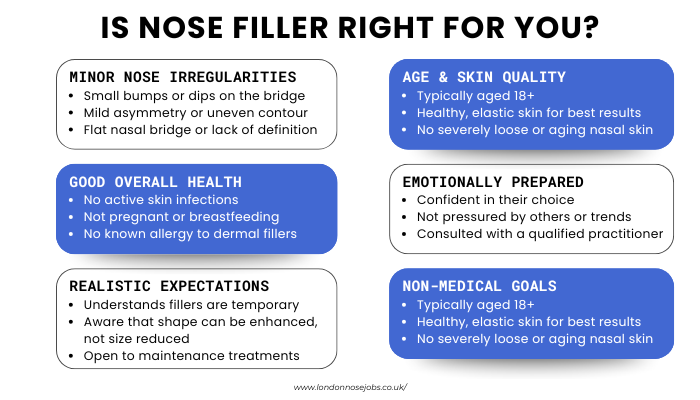If you’re considering a change to your nose but aren’t keen on surgery, you might be curious about permanent fillers for the nose. This option offers a way to enhance your facial features without the need for invasive procedures.
But how do these permanent fillers work, and are they right for you? Let’s break it down.
Key Takeaways
- Permanent fillers for the nose provide lasting results compared to temporary options.
- The procedure is quick, usually taking less than an hour, with minimal downtime.
- It’s important to choose a qualified practitioner to minimise risks and complications.
- Candidates should consider their facial structure and overall health before opting for fillers.
- Regular follow-ups and proper aftercare can help maintain the results of permanent fillers.
Understanding Permanent Fillers For Nose
What Are Permanent Fillers?
So, you’re thinking about nose fillers? Unlike temporary fillers that use substances like hyaluronic acid (which can be dissolved if you’re not chuffed with the result), permanent fillers are designed to stay put.
They’re typically made from materials that the body doesn’t break down or absorb. This means the results are, well, permanent. It’s a bit like getting a tattoo – you’re in it for the long haul.
How Do They Differ From Temporary Fillers?
The main difference is, unsurprisingly, the duration. Temporary fillers usually last anywhere from six months to a couple of years. They’re great if you want to test the waters or fancy a change down the line. Permanent fillers, on the other hand, are meant to be a one-time deal.
Here’s a quick comparison:
| Feature | Temporary Fillers | Permanent Fillers |
|---|---|---|
| Duration | 6 months – 2 years | Permanent |
| Material | Hyaluronic acid, etc. | Various synthetic materials |
| Reversibility | Yes | Generally No |
| Adjustability | Yes | Limited |
Benefits Of Permanent Fillers
The big draw of permanent fillers is the idea of ‘set it and forget it’. No more top-up appointments every year! For some, this is a massive convenience.
Plus, over time, it could work out cheaper than constantly getting temporary fillers. However, it’s worth really thinking about whether you want a change that lasts forever. Tastes change, and what looks good now might not in ten years.
It’s really important to weigh up the pros and cons. Permanent fillers can offer long-lasting results, but they also come with a higher level of commitment. Make sure you’re absolutely certain about the look you want before taking the plunge.
The Procedure For Permanent Nose Fillers
What To Expect During The Treatment
Let’s walk through what happens during the treatment. First off, a consultation is key. Your practitioner will assess your nose, discuss your goals, and explain the procedure in detail. On the day, the area will be cleaned and numbed with a local anaesthetic.
This bit is important to minimise discomfort. The filler is then injected in small amounts, carefully shaping your nose. The whole process usually takes between 30 minutes to an hour. You might feel some pressure, but it shouldn’t be painful.
Recovery Time And Aftercare
The recovery time is generally quite minimal. You might experience some swelling, redness, or bruising, but this usually subsides within a few days.
Here’s a few things to keep in mind:
- Avoid touching or applying pressure to your nose for the first few days.
- Sleep on your back to prevent any accidental squashing.
- Skip strenuous exercise for about a week.
- Follow any specific aftercare instructions your practitioner gives you – they know best!
It’s important to remember that everyone’s recovery is different. If you have any concerns, don’t hesitate to contact your practitioner. They’re there to support you through the process.
Potential Risks And Complications
Right, let’s talk about the less glamorous side of things – potential risks and complications. While permanent nose fillers can be a great option, it’s important to be aware of what could happen.
Here are some possible risks:
- Infection: As with any injection, there’s a risk of infection. This is why it’s so important to choose a qualified and experienced practitioner who uses sterile equipment.
- Migration: Although rare, the filler could potentially move from the injection site.
- Nodules: Small lumps or bumps might form under the skin. These can sometimes be treated with medication or, in some cases, may need to be surgically removed.
It’s worth noting that serious complications are rare, but it’s always best to be informed. Discuss any concerns you have with your practitioner – they can help you weigh the risks and benefits and make an informed decision.
Comparing Permanent And Temporary Fillers
Longevity Of Results
Nose fillers, usually made with hyaluronic acid, last anywhere from six months to a year, maybe a bit longer for some people. Permanent fillers, on the other hand, are designed to stick around indefinitely.
That sounds great, but it’s a double-edged sword. If you love the result, fantastic. If you don’t? Well, that’s a problem.
Cost Considerations
At first glance, permanent nose job might seem cheaper because you only pay once. But think long-term. Temporary fillers require repeat treatments, yes, but this also gives you a chance to tweak things as your face changes with age.
Plus, if you have any issues, temporary fillers can be dissolved. Permanent ones? Not so much. So, while the upfront cost might be higher for temporary fillers, it could save you money (and stress) in the long run.
Flexibility And Adjustability
This is where temporary fillers really shine. Our faces change over time, and what looks great now might not in five or ten years. With temporary fillers, you can adjust the amount and placement to keep up with these changes.
If you decide you don’t like the filler at all, it can be dissolved. Permanent fillers? You’re stuck with them. This lack of flexibility is a major consideration.
Choosing between permanent and temporary fillers really boils down to your personal preferences and risk tolerance. Permanent fillers offer a one-time solution, but temporary fillers provide the flexibility to adapt to changing aesthetics and correct any issues that may arise. It’s worth chatting with a practitioner to see what they think is best for you.
Who Is A Suitable Candidate?

Deciding whether permanent nose fillers are right for you involves several important considerations. It’s not just about wanting a change; it’s about ensuring the procedure aligns with your facial structure, health, and expectations. Let’s explore the key aspects that determine if you’re a good candidate.
Assessing Your Facial Structure
Before diving into permanent fillers, it’s essential to understand how they’ll complement your overall facial harmony. Permanent fillers are best suited for subtle enhancements rather than dramatic transformations. Think about refining the bridge or tip, not completely reshaping your nose.
A good candidate typically has a well-defined facial structure where minor adjustments can make a noticeable, positive difference. It’s about balance and proportion.
Consultation Process
The consultation is a critical step. It’s your chance to discuss your goals, concerns, and medical history with a qualified practitioner. During this session, the practitioner will assess your nasal anatomy, skin quality, and overall health to determine if permanent fillers are a suitable option for you.
They’ll also explain the procedure in detail, including potential risks and complications. Here’s what you can expect during a consultation:
- A thorough examination of your nose and facial structure.
- Discussion of your desired outcomes and expectations.
- Review of your medical history and any existing health conditions.
- Explanation of the procedure, including potential risks and benefits.
Health Considerations
Your overall health plays a significant role in determining your suitability for permanent nose fillers. Certain medical conditions, such as autoimmune diseases, bleeding disorders, or active skin infections, may increase the risk of complications.
It’s crucial to disclose your complete medical history to your practitioner to ensure your safety. Additionally, smokers may experience delayed healing and increased risk of infection, so quitting smoking before the procedure is highly recommended.
Remember, permanent fillers are a long-term commitment. It’s important to be in good health and have realistic expectations about the results. A thorough consultation with a qualified practitioner is essential to determine if this procedure is right for you.
Expert Insights On Permanent Fillers
Choosing The Right Practitioner
Finding the right practitioner is really important. It’s not just about picking someone nearby; it’s about finding someone with the right experience and a good understanding of facial anatomy.
Look for qualifications, check before-and-after photos, and don’t be afraid to ask loads of questions. A good practitioner will be happy to answer them and will make you feel comfortable and confident in their abilities.
Patient Testimonials
Patient testimonials can be a really useful source of information. Hearing about other people’s experiences can give you a better idea of what to expect from the procedure.
However, it’s important to remember that everyone’s experience is different, and what worked for one person might not work for another.
It’s important to remember that permanent fillers, while offering a long-term solution, also come with considerations regarding reversibility and potential complications. Always weigh the benefits against the risks and have a thorough discussion with your practitioner.
Here’s a quick checklist to consider when reviewing testimonials:
- Look for detailed accounts, not just simple praise.
- Consider the source – are they verified patients?
- Note any mentions of complications or aftercare experiences.
Alternatives To Permanent Fillers
If you’re exploring options for nose reshaping, it’s good to know that permanent fillers aren’t the only game in town. There are several other routes you can take, each with its own set of pros and cons. Let’s have a look at some of them.
Surgical Options
Rhinoplasty, or a surgical nose job, is the classic, permanent solution. It involves reshaping the bone and cartilage of your nose to achieve the desired look. It’s more invasive than fillers, obviously, and requires a longer recovery period.
However, it can address more complex issues that fillers simply can’t fix. If you’re after significant changes, surgery might be the way to go. It’s a big decision, so weigh it up carefully.
Non-Surgical Alternatives
If surgery sounds too intense, there are other non-surgical options to consider. Temporary fillers, like those made from hyaluronic acid, are a popular choice. They offer a less permanent way to tweak your nose shape, and the results typically last from 6 to 18 months.
Nose Thread Lifts are also an option. They use threads to lift and reshape the nose, with results lasting around 1-2 years. These methods are less invasive and offer a chance to ‘test drive’ a new nose shape before committing to anything permanent.
Maintaining Results With Permanent Fillers
Follow-Up Treatments
Even though they’re called permanent fillers, that doesn’t always mean zero maintenance. It’s more like ‘very long-lasting’ rather than ‘never needs a thing’.
- Regular Check-ups: Schedule check-ups with your practitioner. They can assess the filler’s condition and the surrounding tissue.
- Top-Ups (Potentially): While the filler itself is permanent, the surrounding tissue and your facial structure will change over time. Minor adjustments might be needed to maintain the desired look.
- Early Intervention: Addressing any minor issues early can prevent them from becoming bigger problems down the line.
Skincare Recommendations
Your skin’s health plays a big role in how your fillers look over time. Good skincare isn’t just about vanity; it’s about supporting the structure underneath.
- Sun Protection: This is non-negotiable. UV rays break down collagen and can affect the appearance of fillers. Use a high SPF daily.
- Hydration: Keep your skin hydrated from the inside out. Drink plenty of water and use a good moisturiser.
- Gentle Products: Avoid harsh chemicals or abrasive scrubs that could irritate the skin around the filler.
Lifestyle Factors Affecting Longevity
Believe it or not, your daily habits can impact how well your fillers hold up. It’s not just about what you put on your face, but how you treat your body in general.
- Healthy Diet: A balanced diet rich in vitamins and antioxidants supports skin health and can help maintain the filler’s appearance.
- Avoid Smoking: Smoking damages collagen and elastin, which can accelerate the ageing process and affect the filler.
- Manage Stress: Chronic stress can impact your skin and overall health. Find healthy ways to manage stress, like exercise or meditation.
Remember, maintaining the results of permanent fillers is a collaborative effort between you and your practitioner. By following these recommendations, you can help ensure that your nose continues to look its best for years to come.
Conclusion
While there isn’t a truly permanent filler for the nose, the options available today offer a flexible and effective way to enhance your appearance without the need for surgery. If you’re considering this route, it’s important to consult with a qualified professional and ask for a FREE consultation who can guide you through the process and help you achieve the results you desire.
Remember, the beauty of fillers lies in their temporary nature, allowing you to adjust your look as your preferences change. So, if you’re looking for a non-invasive way to refine your nose, nose fillers could be a great choice for you.
Frequently Asked Questions
What exactly is a nose filler?
A nose filler is a quick, non-surgical way to change the shape of your nose. It uses special gels to enhance or smooth out the nose’s appearance without surgery.
How long do the effects of a nose filler last?
The results of a nose filler can last from 6 to 12 months, depending on the type of filler used and how your body reacts to it.
Is there any downtime after getting a nose filler?
No, there is usually no downtime. You can return to your normal activities right after the treatment.
Are there any risks involved with nose fillers?
Like any procedure, there can be risks. You might experience swelling or bruising, but serious complications are rare if done by a skilled practitioner.
Can I adjust my nose filler if I don’t like the results?
Yes, one of the benefits of nose fillers is that they can be adjusted. If you’re not happy, your practitioner can make changes during follow-up visits.
Who is a good candidate for nose fillers?
Most people looking for a subtle change in their nose shape can be good candidates. However, it’s best to have a consultation with a qualified professional to see if it’s right for you.





